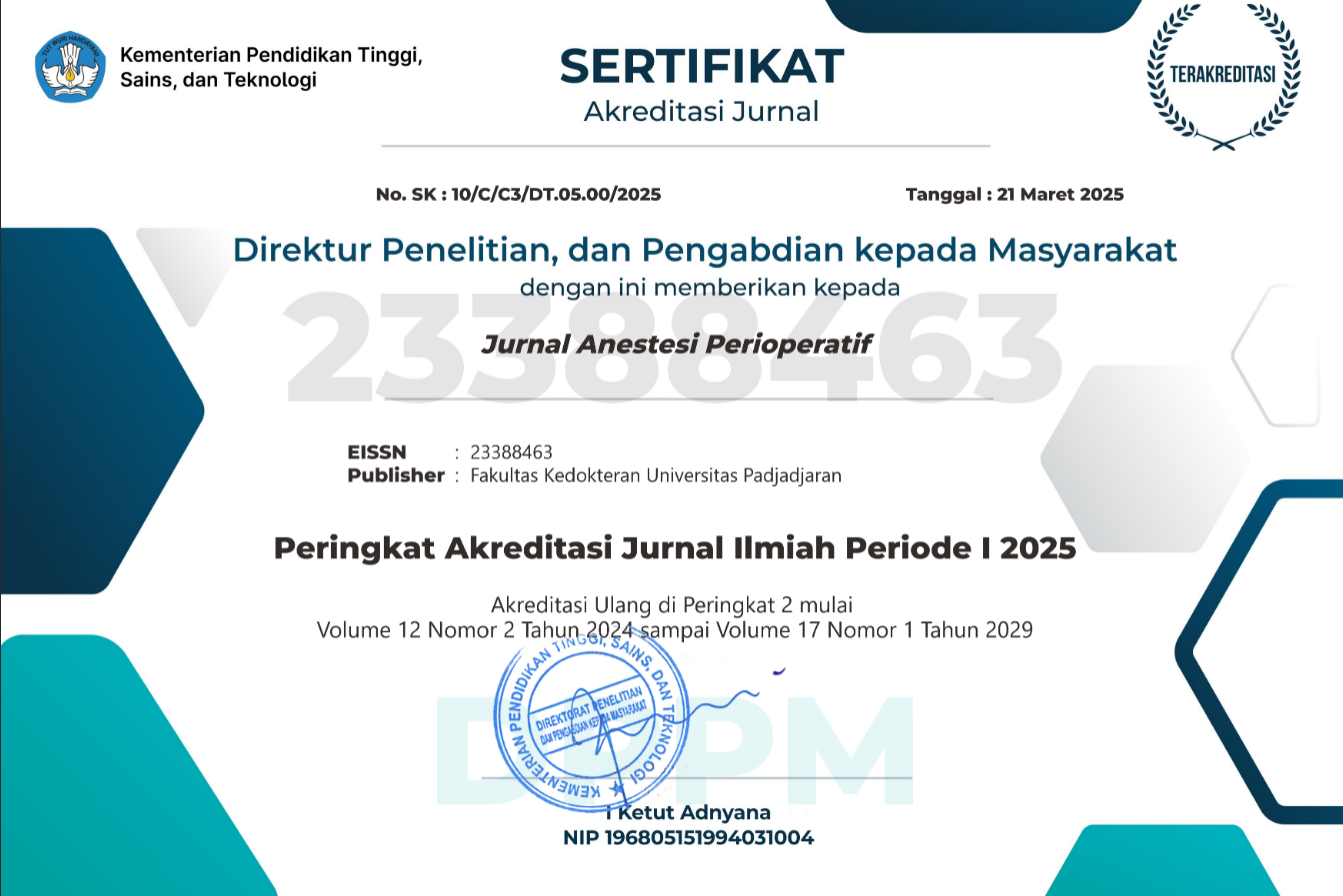Gambaran Jenis Bakteri pada Ujung Kateter Epidural di Rumah Sakit Dr. Hasan Sadikin Bandung
Abstract
Analgesia epidural merupakan metode yang efektif untuk tatalaksana pengelolaan nyeri pascaoperatif. Meskipun jarang, infeksi dapat terjadi setelah proses pemasangan kateter epidural. Penelitian ini bertujuan untuk mengetahui apakah ada bakteri pada ujung kateter epidural dan bakteri apa yang tersering pada ujung kateter epidural. Penelitian ini adalah penelitian deskriptif prospektif yang dilakukan terhadap 52 orang pasien yang menjalani anestesi epidural dan digunakan sebagai analgetik epidural selama bulan Februari 2014 di Rumah Sakit Dr. Hasan Sadikin Bandung. Anastesi epidural dipasang dengan tindakan aseptik dan antiseptik sebelum operasi dan kemudian digunakan sebagai analgetik epidural setelah hari ketiga kateter epidural dicabut dengan tindakan antiseptik dan aseptik sebelumnya kemudian dibuat apus mengunakan swab steril dan diperiksakan kultur bakteri di laboratorium mikrobiologi, Patologi Klinik di Rumah Sakit Dr. Hasan Sadikin Bandung. Hasil penelitian ini didapatkan 14 dari 52 kateter epidural yang dipasang pada bulan Februari 2014 terkontaminasi oleh bakteri. S. epidermidis, S. hominis, dan Acinetobacter baumannii merupakan bakteri yang ditemukan pada ujung kateter epidural. Simpulan, didapatkan hasil 26% dari 52 ujung kateter yang digunakan sebagai analgetik epidural terkontaminasi oleh bakteri. Bakteri yang tersering yang ditemukan di dalam rongga epidural adalah Staphylococcus epidermidis diikuti oleh Staphylococcus hominis dan Acinetobacter baumannii.
Kata kunci: Analgesia epidural, kultur bakteri, ujung kateter epidural
Bacterial Profile of Epidural Catheters Tips in Dr. Hasan Sadikin General Hospital Bandung
Abstract
Epidural analgesia is an effective method for post-operative pain management . Although rare, the infection may occur after an epidural catheter insertion process. There are very few reported cases; however some cases of infection, such as epidural abscess, is are serious and life threatening cases if not diagnosed early and treated well. The aim of this study was to prove the presence of bacterial contamination on epidural catheters tips and to describe the kind of bacteria found. This descriptive prospective study was conducted on 52 patients who used epidural anesthesia and epidural analgesics during the month of February 2014 in Dr Hasan Sadikin Hospital General Bandung. Epidural anesthesia was performed using antiseptic and aseptic procedures before the surgery, then used as epidural analgesia. After the third day, the catheter was removed using aseptic and antiseptic procedures and the tip catheter was smeared by a sterile swab. Cultures were then grown and examined at the microbiology laboratory of the Clinical Phatogology Department of Dr. Hasan Sadikin General Hospital Bandung. It was revealed that 14 of 52 epidural catheters placed during the month of February 2014 were contaminated by bacteria. S. epidermidis, S. hominis, and Acinetobacter baumannii were found on epidural catheter tips. It is concluded in this study that 26.3% of 52 catheter tips used as an epidural analgesic were contaminated by bacteria. The most common bacteria found in the epidural space is Staphylococcus epidermidis, followed by Staphylococcus hominis and Acinetobacter baumannii.
. Although rare, the infection may occur after an epidural catheter insertion process. There are very few reported cases; however some cases of infection, such as epidural abscess, is are serious and life threatening cases if not diagnosed early and treated well. The aim of this study was to prove the presence of bacterial contamination on epidural catheters tips and to describe the kind of bacteria found. This descriptive prospective study was conducted on 52 patients who used epidural anesthesia and epidural analgesics during the month of February 2014 in Dr Hasan Sadikin Hospital General Bandung. Epidural anesthesia was performed using antiseptic and aseptic procedures before the surgery, then used as epidural analgesia. After the third day, the catheter was removed using aseptic and antiseptic procedures and the tip catheter was smeared by a sterile swab. Cultures were then grown and examined at the microbiology laboratory of the Clinical Phatogology Department of Dr. Hasan Sadikin General Hospital Bandung. It was revealed that 14 of 52 epidural catheters placed during the month of February 2014 were contaminated by bacteria. S. epidermidis, S. hominis, and Acinetobacter baumannii were found on epidural catheter tips. It is concluded in this study that 26.3% of 52 catheter tips used as an epidural analgesic were contaminated by bacteria. The most common bacteria found in the epidural space is Staphylococcus epidermidis, followed by Staphylococcus hominis and Acinetobacter baumannii.
Key words: Analgetic epidural, bacterial cultur, epidural catheter tip
Keywords
Full Text:
PDFArticle Metrics
Abstract view : 859 timesPDF - 719 times
This Journal indexed by

JAP is licensed under a Creative Commons Attribution-NonCommercial 4.0 International License
View My Stats



